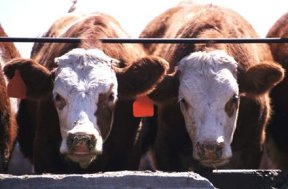The Beef about UTIs
- More than 2 years ago
Urinary tract infections (UTIs) are the most common infectious disease in women. Bacteria, viruses, and fungi frequently invade the urinary tract without causing infection. However, about one-third of U.S. women come down with at least one UTI before the age of 24 that requires medical treatment, and about half get a UTI in their lifetimes.

The symptoms of this infection are hard to miss—and for more and more women, the infections are becoming hard to manage. An increasing number of UTIs are resistant to the drugs used most commonly to treat them.
According to new research, this wave of multidrug-resistant UTIs may have a surprising source: eating meat. In a recent study, Lee Riley at the University of California, Berkeley and his colleagues link a multidrug-resistant strain of Escherichia coli isolated from beef cattle to clusters of UTIs in women across the country.
E. coli “is the source of well-recognized foodborne bacteria infections,” says Riley. If women can get UTIs from the food they eat, “that is a major public health concern,” he says.
Creepy clusters
Riley usually studies outbreaks of foodborne diarrhea. He got interested in UTIs when one of his graduate students wanted to track drug-resistant UTIs on the Berkeley campus. After tallying UTIs treated at the school’s student-health center in the late 1990s, Riley’s team found that about 22 percent of the infections were resistant to sulpha drugs, which are medications frequently used to fight UTIs.
“That in itself wasn’t surprising,” says Riley. What was unusual, however, was that about 50 percent of the infections were caused by an identical strain of E. coli. Riley and his colleagues found the extraordinary degree of similarity by fingerprinting the bacteria, or sequencing small portions of their DNA. “When E. coli bacteria can have thousands of different fingerprints, it didn’t make sense that about half of those in these students had the same pattern.”
UTIs are most frequently caused when bacteria, usually E. coli, makes its way from the bowels to the urethra. The distance between these two openings is shorter in women, so they tend to get UTIs more frequently than men do. Since every person carries a unique variety of bacterial strains in his or her bowels, having clusters of UTIs that share an identical type of bacteria is unexpected.
Riley’s group then fingerprinted E. coli from UTI infections at eight other clinics across the United States. In 2001 and 2002 medical-journal articles, the researchers reported finding more groups of people infected with the same UTI-causing bacterium that had turned up in Berkeley.
By this point, Riley realized that the drug-resistant infection clusters he and his students were observing were suspiciously similar to those that he had previously studied in outbreaks of foodborne disease. Since drug-resistant microbes in food usually trace to livestock, the researchers next focused on farm animals. Riley’s team suspected that by eating meat from an infected animal, women had inadvertently sown their intestines with drug-resistant bacteria that later produced UTIs.
Using a large collection of bacteria samples isolated from U.S. livestock animals over the past several decades, Riley’s group searched for an E. coli strain similar to the one linked to all the clusters of UTIs. Adding evidence to support their hypothesis, the scientists found that a single E. coli strain taken from a cow in 1988 shared about 94 percent similarity to the UTI strain they’d been studying. The comparison was based on the proteins bacteria carry on their surfaces. These protein arrays, or serotypes, offer researchers a way to assess the relatedness of bacteria. The researchers will publish this finding in the Jan. 15 Clinical Infectious Diseases.
Go with the flow
While his groups’ recent results aren’t proof that UTIs stem from a foodborne bacterium, Riley says he’s “highly suspicious” that food is the source of the UTIs observed. He notes that many more studies will be necessary to verify his team’s hypothesis.
If the idea is proved correct, it will add one more example to a growing list of ways that livestock-isolated antibiotic-resistant bacteria can make people ill (SN: 1/1/05 p. 5; SN: 10/20/01, p. 246), says UTI researcher Betsy Foxman of the University of Michigan School of Public Health in Ann Arbor.
“It is highly likely that antibiotic resistance is transferred between animals and humans. That’s been demonstrated very effectively in previous studies,” says Foxman. “We have to think of what we do in animals as very much influencing what happens with human antibiotic resistance.”
Foxman says that such antibiotic resistance in UTIs is troubling because the infections are most often treated empirically, in that physicians prescribe medications based on a patient’s symptoms instead of identifying causative bacteria in a lab test. Therefore, antibiotics not only won’t clear up antibiotic-resistant UTIs, but the drugs might also encourage the growth of other antibiotic-resistant bacteria.
Additionally, she notes that the increasing range of antibiotics that farmers use to enhance livestock growth and prevent infections in crowded animal feedlots, and microbes’ development of resistance to those compounds, is narrowing the list of drugs available to effectively fight human infection. “There are very few new antibiotics left in the pipeline,” Foxman says.
In the meantime, Ellen Kruger, an obstetrician and gynecologist at the Ochsner Clinic Foundation in New Orleans, says that women can avoid getting antibiotic-resistant UTIs by practicing “commonsense hygiene”: wipe from front to back after bowel movements, and drink plenty of water to flush bacteria from the urethra.







